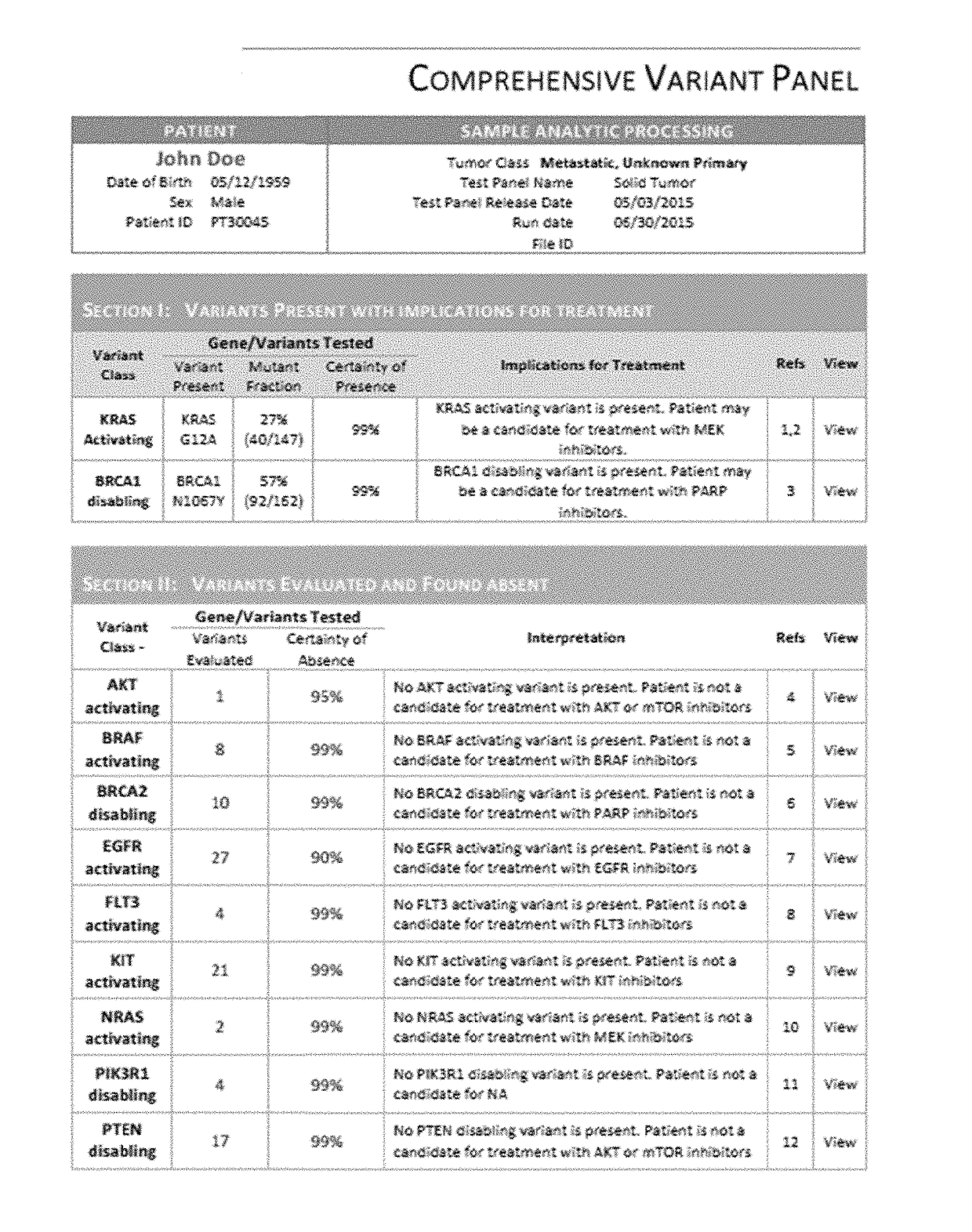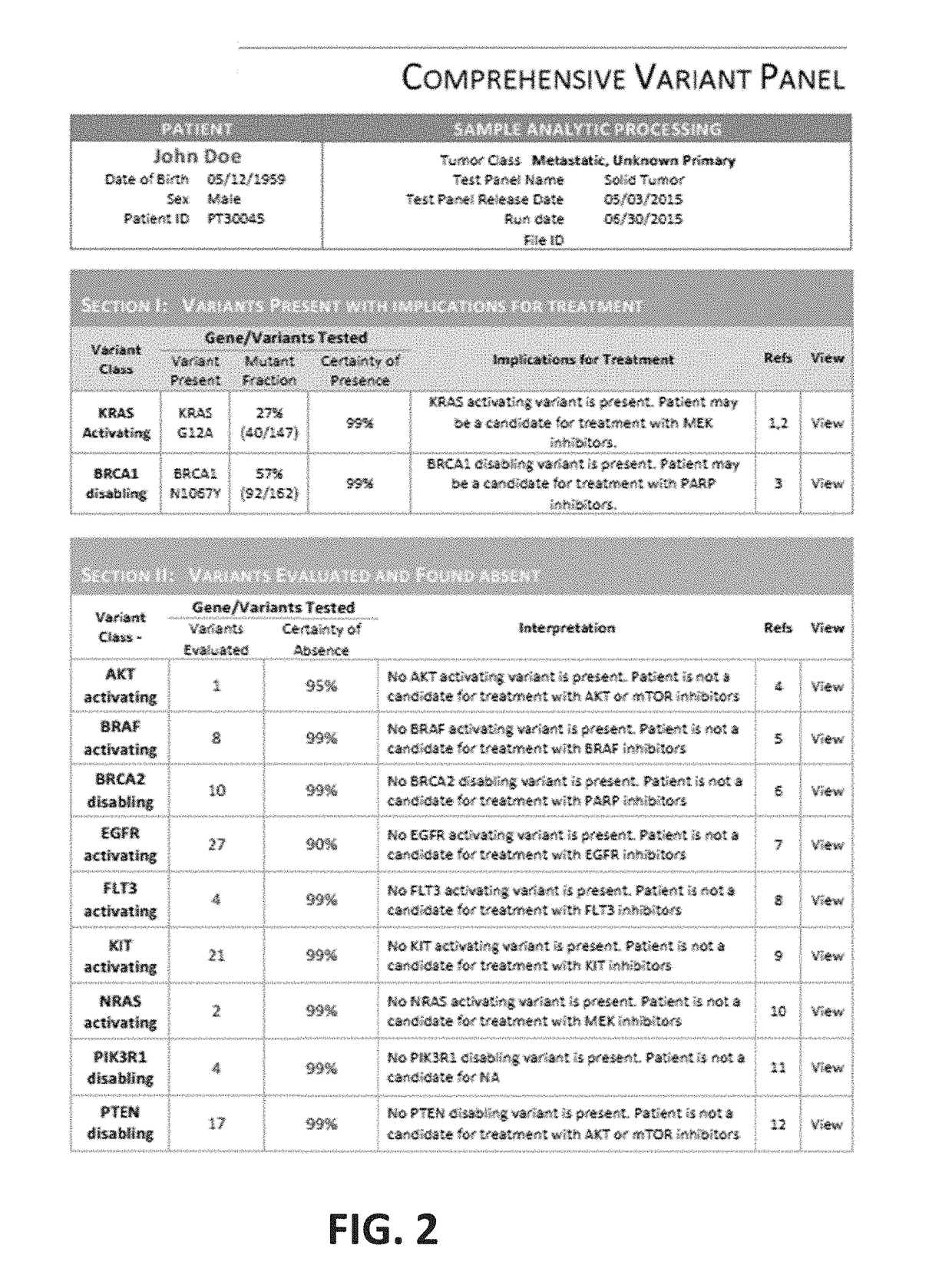Methods and systems for sequencing-based variant detection
a technology of variant detection and sequencing, applied in the field of methods and systems for sequencing-based variant detection, can solve the problems of limitation, unfavorable clinical decision-making, and current variant calling algorithms and methods not being able to positively identify the absence of a variant, and achieve the effect of positive predictive valu
- Summary
- Abstract
- Description
- Claims
- Application Information
AI Technical Summary
Benefits of technology
Problems solved by technology
Method used
Image
Examples
example 1
ng Genetic Variants in a Cohort of Cancer Samples
[0104]Sequencing will soon be an essential tool in the diagnostic workup of solid tumors. Of the more than 700 oncology drugs in the clinical development pipeline, 73% are expected to require a biomarker. Improved software systems are needed to manage the complexity of multiple-marker testing. A software system was built that would reliably deliver concordant results across variations in cancer type, tissue preservation, and target enrichment with high-performance, medical-grade analytics that could be readily validated and integrated into the solid tumor workflow at most pathology laboratories.
[0105]54 samples, from 5 different laboratories' published data, were chosen to represent a diverse mix of processing conditions and tumor types. The criterion for selection was the presence of one or more actionable variants in AKT, ALK, BRAF, BRCA1, CDKN2A, EGFR, KRAS, NRAS, PIK3CA, PIK3R1 or PTEN. 37 samples were from patient tumors, includi...
example 2
ction of Variant Panel
[0107]A user (i.e., healthcare practitioner or clinical laboratory) accesses a user portal of the disclosure. The user is presented with a menu of clinically actionable variants that can be selected for querying. The user can select a pre-set or pre-defined variant panel that comprises a plurality of clinically actionable variants related to a particular disease (e.g., prostate cancer). The user determines that two of the clinically actionable variants in the panel are not of interest and deselects or removes the two clinically actionable variants from the panel. The user also adds to the panel three genetic variants that have been recently described in a scientific publication as being correlated with treatment response in prostate cancer. The user saves the panel selection and transmits the panel selection to the server. The user uploads two FASTQ file formats to the server comprising target-enriched sequencing data of a patient suffering from prostate cancer...
example 3
tware System Demonstrating High Concordance in Study with Multi-Laboratory Data
[0108]Sequencing will soon be an essential tool in the diagnostic workup of solid tumors. Of the more than 700 oncology drugs in the clinical development pipeline, 73% are expected to require a biomarker. Improved software systems are needed to manage the complexity of multiple-marker testing.
[0109]A new software system was constructed that would reliably deliver concordant results across variations in cancer type, tissue preservation, and target enrichment with high-performance, medical-grade analytics that could be readily validated and integrated into the solid tumor workflow at most pathology laboratories. Briefly described are findings from an initial verification study.
[0110]The goals of the study were to evaluate whether a single, standard analytic core can deliver consistent performance with data representing the broad range of conditions expected in clinical use: various tissue types and preserva...
PUM
| Property | Measurement | Unit |
|---|---|---|
| depth of coverage | aaaaa | aaaaa |
| nucleic acid | aaaaa | aaaaa |
| refractory | aaaaa | aaaaa |
Abstract
Description
Claims
Application Information
 Login to View More
Login to View More - R&D
- Intellectual Property
- Life Sciences
- Materials
- Tech Scout
- Unparalleled Data Quality
- Higher Quality Content
- 60% Fewer Hallucinations
Browse by: Latest US Patents, China's latest patents, Technical Efficacy Thesaurus, Application Domain, Technology Topic, Popular Technical Reports.
© 2025 PatSnap. All rights reserved.Legal|Privacy policy|Modern Slavery Act Transparency Statement|Sitemap|About US| Contact US: help@patsnap.com



